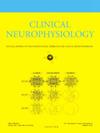Shapes of direct cortical responses vs. short-range axono-cortical evoked potentials: The effects of direct electrical stimulation applied to the human brain
IF 3.6
3区 医学
Q1 CLINICAL NEUROLOGY
引用次数: 0
Abstract
Objective
Direct cortical responses (DCR) and axono-cortical evoked potentials (ACEP) are generated by electrically stimulating the cortex either directly or indirectly through white matter pathways, potentially leading to different electrogenic processes. For ACEP, the slow conduction velocity of axons (median ≈ 4 m.s−1) is anticipated to induce a delay. For DCR, direct electrical stimulation (DES) of the cortex is expected to elicit additional cortical activity involving smaller and slower non-myelinated axons. We tried to validate these hypotheses.
Methods
DES was administered either directly on the cortex or to white matter fascicles within the resection cavity, while recording DCR or ACEP at the cortical level in nine patients.
Results
Short but significant delays (≈ 2 ms) were measurable for ACEP immediately following the initial component (≈ 7 ms). Subsequent activities (≈ 40 ms) exhibited notable differences between DCR and ACEP, suggesting the presence of additional cortical activities for DCR.
Conclusion
Distinctions between ACEPs and DCRs can be made based on a delay at the onset of early components and the dissimilarity in the shape of the later components (>40 ms after the DES artifact).
Significance
The comparison of different types of evoked potentials allows to better understand the effects of DES.
皮层直接反应与短程轴突皮层诱发电位的形状:直接电刺激对人脑的影响。
目的:直接皮层反应(DCR)和轴皮层诱发电位(ACEP)是通过直接或间接白质通路电刺激皮层产生的,可能导致不同的电原过程。对于 ACEP,轴突的慢传导速度(中位数≈ 4 m.s-1)预计会引起延迟。对于 DCR,对大脑皮层的直接电刺激(DES)预计会引起额外的皮层活动,其中涉及较小和较慢的非髓鞘轴突。我们试图验证这些假设:方法:在九名患者的皮层水平记录 DCR 或 ACEP 的同时,直接在皮层或切除腔内的白质束上进行 DES:在初始成分(≈ 7 毫秒)之后,ACEP 可立即测量到短暂但明显的延迟(≈ 2 毫秒)。随后的活动(≈ 40 毫秒)在 DCR 和 ACEP 之间表现出明显的差异,表明 DCR 存在额外的皮层活动:结论:ACEP 和 DCR 之间的区别可以根据早期成分开始时的延迟和后期成分(DES 伪影之后大于 40 毫秒)形状的不同来区分:意义:通过比较不同类型的诱发电位,可以更好地了解 DES 的影响。
本文章由计算机程序翻译,如有差异,请以英文原文为准。
求助全文
约1分钟内获得全文
求助全文
来源期刊

Clinical Neurophysiology
医学-临床神经学
CiteScore
8.70
自引率
6.40%
发文量
932
审稿时长
59 days
期刊介绍:
As of January 1999, The journal Electroencephalography and Clinical Neurophysiology, and its two sections Electromyography and Motor Control and Evoked Potentials have amalgamated to become this journal - Clinical Neurophysiology.
Clinical Neurophysiology is the official journal of the International Federation of Clinical Neurophysiology, the Brazilian Society of Clinical Neurophysiology, the Czech Society of Clinical Neurophysiology, the Italian Clinical Neurophysiology Society and the International Society of Intraoperative Neurophysiology.The journal is dedicated to fostering research and disseminating information on all aspects of both normal and abnormal functioning of the nervous system. The key aim of the publication is to disseminate scholarly reports on the pathophysiology underlying diseases of the central and peripheral nervous system of human patients. Clinical trials that use neurophysiological measures to document change are encouraged, as are manuscripts reporting data on integrated neuroimaging of central nervous function including, but not limited to, functional MRI, MEG, EEG, PET and other neuroimaging modalities.
 求助内容:
求助内容: 应助结果提醒方式:
应助结果提醒方式:


